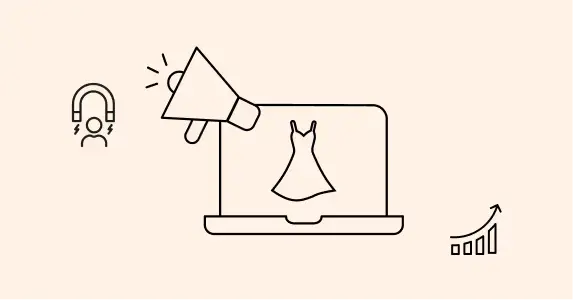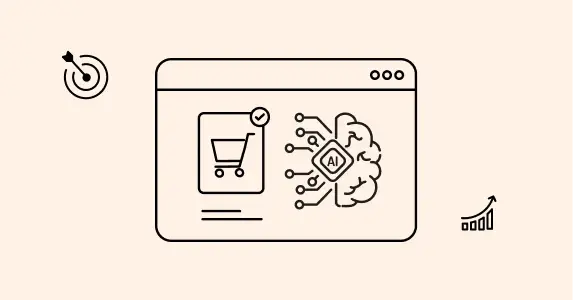In the glittering fashion world, the first sale is a moment of triumph—a customer walks away with a piece of your brand’s identity. But the second sale? That’s where the real alchemy happens. It transforms fleeting interest into enduring loyalty, transactional buyers into brand advocates, and seasonal trends into timeless legacies.
Yet, in an era of skyrocketing customer acquisition costs (CAC) and ever-shortening attention spans, fashion brands face a daunting challenge: 60% of consumers switch brands after just one purchase if the post-purchase experience fails to resonate. With margins tightening and competition intensifying, the brands that thrive won’t be those chasing viral moments—they’ll be the ones mastering the subtle art of turning first-time buyers into lifelong devotees.
Why the Second Sale Is Perhaps Your Most Important Sale
Let’s cut through the noise: Acquiring a new customer costs 5–7x more than retaining an existing one. For fashion brands, where aesthetics, identity, and emotional connection drive decisions, repeat customers aren’t just profitable but essential.
Consider these stakes:
- Loyal customers spend 67% more than new ones (Business.com).
- Increasing retention by just 5% boosts profits by 25–95% (Harvard Business Review).
- 44% of fashion revenue comes from repeat buyers
But here’s the catch: Fashion isn’t utilities or groceries. Loyalty here isn’t built on necessity—it’s earned through relevance, exclusivity, and experience. A second sale isn’t merely another transaction; it’s a vote of confidence in your brand’s ability to evolve with the customer’s identity. Let’s dive into the strategies that separate fleeting wins from lasting loyalty.
Strategy 1: Build Smart Post-Purchase Journeys — The 72-Hour Rule
The moment a customer checks out, the countdown begins. The first 72 hours are critical—this is when your post-purchase engagement should kick in. Studies show that 20% of shoppers make a second purchase within 90 days—but only if the brand connects with them early. Missing this window, you risk losing momentum (and the customer).
Step 1: Make Your Boring Post-Purchase Emails Fun
Instead of generic “Your order has shipped” emails, use this touchpoint to reinforce brand ethos. For example:
- A luxury knitwear brand includes a preview of “How to Style Your Cashmere Scarf” in tracking emails. If you are brave enough, add bundled offers for warm socks or woolly gloves that would excite shoppers.

- Another example is is if you are a sustainable sneaker brand, share the carbon footprint saved by your customers’ purchases, linking to a “Shop More Eco-Conscious Picks” page. We know that kind of messaging will undoubtedly resonate with Gen Z.
Take Note – Embed UGC (user-generated content) in post-purchase flows. When customers see carousels and accordions ( which you can directly embed in your emails with Netcore ) of others styling their purchases, it validates their choice and sparks ideas for future buys.

Step 2: Personalize Product Pairings with Precision
Now that you’ve made your first sale, you’ll have preference and behavioral data to analyze the first purchase and suggest complementary items. For instance:
- A customer buys a midi skirt? Recommend tights in their preferred color palette and a trending blouse.
- Use dynamic recommendation blocks on your website, app, or even email to showcase similar best-selling products in the form of “You may also like” recommendations.

Case Study: Netcore ramped up widgets for the world’s beloved casual footwear brand – Crocs, and made them see a 42x uplift in ROI. Learn more about this feat.
Strategy 2: Make Discovery Addictive Even After The First Purchase

Second purchases don’t happen by chance—they happen when brands remember and build on the first. And one of the most powerful yet overlooked tools? The search bar.
With Netcore Unbxd, every keystroke becomes an opportunity. Its AI-powered search suggests products, categories, and filters based on affinity signals from the shopper’s first purchase. Bought a structured blazer? The next search might autosuggest “pleated trousers” or “workwear heels”—stylistic complements that feel natural and personal.
These in-bar suggestions aren’t static—they evolve with each visit, reinforcing brand relevance and gently guiding the shopper toward a second buy.
Why it matters: The second sale is all about recognition and relevance. Affinity-based search recommendations help customers feel seen, turning intent into action, one smart prompt at a time.
Strategy 3: Keep the Conversation In-Channel
The first purchase is just the beginning—what happens after is where loyalty (and revenue) are won. The key? Stay where your shoppers are, and keep the momentum going without forcing them to switch apps, tabs, or devices.
When fashion customers receive an order, they’re still emotionally connected to your brand—excited, curious, and primed to engage. That’s your window to guide them to their second purchase. And the best way to do it? Shoppable, in-channel experiences that trigger action in real time.
Shoppable Emails: Make Every Inbox Tap Count
Post-purchase emails shouldn’t just say “thank you” but “what’s next?” With Netcore’s shoppable email features, you turn passive messages into conversion engines.
- Spin-to-Win Games: Add gamified elements post-purchase with exclusive discounts or reward points. It’s a playful re-engagement trigger that taps into their purchase high—and encourages immediate repeat browsing.
- In-Mail Carts: Let customers add, remove, or adjust product variants (like color or size) inside the email itself. Fewer clicks = higher conversion = faster second sale.
- Zero-Party Data Capture Forms: Ask questions like “What’s your go-to weekend style?” or “How would you rate your last fit?” Their answers fuel better recommendations, restock alerts, and personalized nudges for the next buy.
Check out this sneak peek of what Shoppable Emails look like in action –
Did you know? A leading fashion brand included this functionality in their email stack to improve their orders by 10x. Learn How
WhatsApp and RCS: Your Always-On, Post-Purchase Stylist
Messaging channels like WhatsApp and RCS are where your customers live. Using them post-purchase isn’t just smart—it’s strategic.
- Personalized Check-Ins: A few days after delivery, ask how the fit feels and suggest styling tips or accessories that pair well. This makes your brand feel thoughtful and helps complete the look with a follow-up purchase.
- Flash Sales and VIP Drops: Send early access to returning customers with exclusive WhatsApp-only collections. This drives urgency and rewards loyalty.
- Two-Way Conversations: Let customers reply with sizing or style questions directly. Your AI (or team) can answer fast, boosting trust and shortening the path to cart.

Strategy 4: Real-Time Merchandising Triggers — Convert Hesitation into a Second Sale
In the world of fashion, hesitation often leads to cart abandonment. Shoppers linger, get distracted, or second-guess their choices—and just like that, their cart is forgotten. But what if your brand could step in at just the right moment to reclaim those lost opportunities?

Real-time engagement through personalized triggers can make the difference between a one-time buyer and a repeat customer. With Netcore’s powerful triggers, you can act on customer intent and interests in real-time—nudging them back toward the cart and toward the next purchase, all while keeping the experience relevant, seamless, and rooted in their unique affinities.
Triggers That Convert
- Price Drop Alerts
“That dress you loved? It’s now 20% off!”
Price-sensitive customers are more likely to bite when a discount is on the table. By triggering a price drop alert on a product they previously browsed or saved, you reignite their interest in a way that feels like a special, personalized offer. - Low-Stock Alerts
“Only 3 left in your size!”
Scarcity drives urgency, and fashion shoppers are well aware that certain items sell out quickly. When a shopper sees low stock for a size they’ve shown interest in, the need to act quickly intensifies. - Browse Continuity & Affinity-Based Recommendations
“Still exploring? Here’s what others bought after viewing this blazer.”
When a shopper views an item but doesn’t commit to a purchase, it’s crucial to continue the conversation in a natural and personal way. Netcore’s affinity-based recommendations take it a step further by understanding what shoppers are looking at now and factoring in what they’ve bought previously. For example, if they’ve purchased casual jeans before, showing them a jacket that complements their prior purchase creates a more compelling case for a second buy, turning browsing into decision-making. - Abandoned Cart Triggers with Upsell Potential
“The dress you let go is now only $99!”
It’s a classic, but with a twist: integrate personalized product recommendations alongside cart recovery. Instead of simply reminding a customer about what’s in their cart, suggest complementary items they might need to complete the look, like matching accessories or shoes. For instance, if someone abandons a classic red dress, suggest a pair of heels or a matching handbag based on their previous purchases or browsing behavior. - Peer Influence & Social Proof
“200 people added this skirt to their cart today.”
Social proof is a powerful motivator. In fashion, seeing that others are interested in the same item can prompt customers to act sooner, especially when they’re unsure. Adding peer influence triggers to your messaging creates a sense of community around your products, making shoppers feel like they’re part of a trend or a popular choice. - Weather-Based Geolocation Triggers
“It’s 12°C in Paris—pair your new coat with these gloves.”
Using real-time weather data to recommend relevant products creates a hyper-contextual experience for the shopper. This personal touch increases engagement and drives a sense of timeliness, suggesting items that match current weather conditions means the shopper doesn’t have to think twice. They’re more likely to purchase that scarf or pair of gloves because it’s tailored to where they are right now. This geo-targeting can also include suggestions based on past purchase behavior (e.g., recommending cold-weather accessories to someone recently bought a coat).
Why It Works — The Power of Real-Time and Affinity-Based Merchandising
In fashion, customers don’t just buy a product—they’re buying into a lifestyle, a style statement, a mood. By triggering personalized recommendations based on their past behavior, Netcore helps you stay relevant to their evolving tastes.
Each trigger works because it’s rooted in the shopper’s preferences and immediate needs. By understanding their affinities and behaviors—what they browsed, what they bought, and what they’re looking for next—you can keep the conversation going. Instead of pushing for a hard sell, you’re nurturing a relationship that leads seamlessly to the second sale.
Strategy 5: Reward Engagement, Not Just Purchases — The Loyalty Loop
Loyalty programs that focus solely on transactions feel transactional. Modern shoppers want to feel seen.
Make Non-Purchase Actions Memorable:
- Wishlist Milestones: “You’ve saved 10 items! Unlock a free styling session.”
- Social Shoutouts: Reward customers who tag your brand in outfit posts.
- Content Co-Creation: Invite top engagers to vote on new designs.
Example: A streetwear brand’s “Style Pioneer” program grants early access to customers who share UGC 3+ times monthly.
Tiered Experiences:
Bronze: Free shipping
Silver: Exclusive previews + birthday gifts
Gold: Personal shopper access + event invites
Key Insight: Members of Sephora’s Beauty Insider program drive 80% of annual sales. Fashion can replicate this with style-centric tiers.
The Final Stitch: Turning Customers into Community
The second sale isn’t the endgame—it’s the gateway to building a self-sustaining community. Consider:
Style Tribes: Micro-segment audiences into “Boho Enthusiasts” or “Officecore Pros” for hyper-targeted campaigns.
Localized Experiences: Host pop-ups or virtual meetups for top-tier loyalty members.
Co-Creation Channels: Let customers vote on fabric choices, colorways, or collaborations.
Tools like Netcore unify these efforts by centralizing data, automating personalized journeys, and measuring emotional engagement metrics (e.g., time spent on content, UGC shares).
Conclusion: Loyalty Is the New Luxury
In fashion, where trends fade but legacies endure, the second sale is the ultimate litmus test. It’s proof that your brand doesn’t just clothe bodies—it resonates with identities.
By marrying AI’s precision with the humanity of styling expertise, and wrapping it all in seamless, channel-agnostic experiences, fashion brands can transform one-time buyers into lifelong ambassadors. After all, in a world of fast fashion and faster trends, loyalty is the rarest fabric of all. Ready to weave it into your brand’s future? The next chapter starts with the second sale.
 Holiday Sales Are Won Now — Grab the 2025 Holiday Marketing Guide to Unlock More Revenue.
Holiday Sales Are Won Now — Grab the 2025 Holiday Marketing Guide to Unlock More Revenue. 












